ChuToroZuke's Sake Chroncicles Vol. 1
Hello everyone, ChuToroZuke here! For Volume 1 of The Sake Chronicles, I would like to discuss sake from a high level, what it is about, and why we should drink more of it!
About Japanese sake
Japanese sake is the definitive national alcoholic beverage of Japan. It is deep rooted in history and integral to Japanese food culture, and also used in quite a number of recipes for cooking.
It deserves to be consumed, celebrated and enjoyed for any occassion. With the right sake, the experience of any meal can enhance greatly.
It is also one of the best beverages to have with all styles of food in Japan. Whatever that can go with wine or champagne, sake can do the same job just as well, and in some
cases, much better!
The consumption of sake has unfortunately gone down a lot over the last 10 years, as younger people lose interest and stick with beer or hi-balls (shochu or whiskey cut with ice, water, soda, fruit flavors)
and there is a growing push to have wine and champagne even with traditional Japanese cuisine, as people come into more spending power and have options.
Sake breweries as a result have to change the way they think, produce, and market sake, and thus have to compete with wine, champagne, and other alcoholic beverage to recapture the market, as well as grow market share overseas (e.g. Asia/SE Asia, Taiwan, China, Hong Kong, USA, Europe/UK/France).
However with that said, you can find both modern and traditional profiles/styles of sake in Japan and outside.
As visitors to Japan, I feel we should try to help the sake industry by exploring sake at any opportunity.
In addition to being delicious, especially with food, bottles of sake are excellent souvenirs and gifts!
What is sake made of?
Sake from a high level, is made with the following components.
1) sake brewing water - water quality differs within each prefecture in Japan, as well as mineral content and softness. Purity and source is important.
2) sake brewing rice - There are a number of sake brewing rice varietals, including regional unique rice for sake in various prefectures across Japan. Each can produce unique flavors, and within that, numerous combinations of layers and textures. Generally rice grains have an exterior covering the center (shinpaku) containing all the vital starch. The more of the exterior that is polished, generally the smoother the sake texture, and more fruitier flavors will result (and generally, the more costly the bottle) When you see something that says 精米步合 on a sake bottle, that refers to "semibuai" which is the rice polish ratio as a percentage. If 80%, it means 20% of the rice grain is polished away (and that is in relation to the total weight of the grain). In the case of for example, Dassai 23, and if it is 23% it means 77% of the grain was polished away.
3) koji mold (in Latin scientific term would be Aspergillus), which is also used to make miso, vinegar, soy sauce and shochu, in addition to sake.
4) yeast - an integral part of the conversion process. Yeast consumes sugar to produce alcohol and carbon dioxide. While rice does not contain sugar consumable by yeast,
it is the koji mold mentioned above, that converts the starch in rice to sugar that is consumed by yeast.
Sake is not a wine, but closer to a brew as a result of fermentation of sake rice.
About sake nomenclature and their definitions
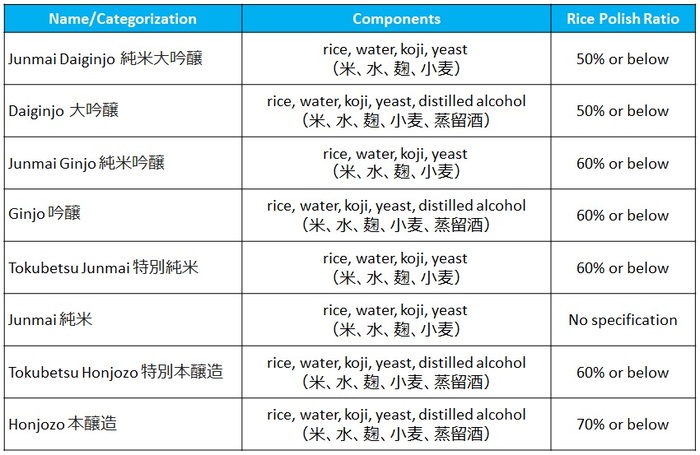
When you come across sake, you may see names like Junmai, Ginjo, Junmai Ginjo, Daiginjo, and Junmai Daiginjo.
Junmai grade sake - the kanji for this translates to "pure rice". Meaning this is brewed entirely with rice (as well as water, koji mold, yeast)
Ginjo grade sake - brewed with sake rice, koji, yeast, brewing water, and distilled alcohol is added to produce (and induce) particular aromas and profiles.
However the words and terminologies can mix a bit:
Other useful terminology
Sometimes you will see other specifications on a bottle label. These pieces of information will give you a better idea of a sake's profile based on dryness level, acidity, and alcohol percentage.
Nihonshudo (SMV) - A rating of 0 would typically mean the sake is neutral, it is neither sweet nor dry. However some people debate that nowadays a rating of 3 is considered neutral.
Generally, the higher the number from the neutral point, the dryer the sake. And 0 or below would indicate more sweetness. The sweetness refers to the residual sugar and alcohol in the sake itself.
You could have a sake that is fruity on the nose, aromatic, and a touch of sweetness on the tip of your tongue, but the sake finishes dry and has a higher SMV value.
Acidity - Most sake hover around the 1.3 to 1.5 range. Traditional more labor intensive methods of sake production tend to result in higher acidity levels, reaching values of 1.6 or higher.
Low temperature long term fermentation and storage could bring that number up a little more as well, and the sake will become more full bodied, more structured, and better suited for food pairing,
much like some red wine profiles.
Alcohol percentage - Sake can have alcohol percentages between 12 to 14% to upwards of 16% or higher. Genshu sake, which are produced by not adding additional water in the brewing process, resulting in more concentration, will generally have higher alcohol content. Summer seasonal releases, and more modern style sake, tend to have lighter alcohol percentage, are easier to drink and generally wider appeal.
Things to pay attention to when tasting a sake
OK so now you get a try a glass of something you are curious about! How do you drink it?
These are things to consider and explore when you taste by itself, and with food:
Aromas on the nose - when you are served the sake, the first thing you should do is smell it and savor the aromas. What do you smell?
It could be a little yeasty (fermentation), earthy (grassy, ricey), fruit scents (apple, pear, melon, lychee, banana), or anything that reminds you of other foods or other scents you are familiar with. I once smelled a sake that reminded me of sandwich meat! There is no right or wrong answer, whatever something reminds you of, you might remember something you had before!
Texture - how does the sake feel in your mouth? Is it smooth, rich, well rounded, velvety, plush, or perhaps has a "bite" or kick to it? Try swirling it around your tongue a little to warm it up a little before swallowing. How does it taste now?
Aromas on the tongue - how does the sake taste from the tip of your tongue, to about mid way back (what we can call the mid palate) all the way to the end? Do you sense any variance? Any difference over time and with food?
Finish - when the sake goes down your throat, how does that feel or taste like? Does it prolong, or is it very quick like drinking water? Do you feel any coating remaining on your tongue? Is there an alcoholic burn that you dislike or perhaps enjoy?
Temperature - now re-try the sake very chilled (5 degrees C), lightly chilled 10 to 15 degrees C, room temperature 15 to 25 degrees C and repeat. What's your favorite spot or moment?
I hope this was a helpful start!
Feel free to leave comments or questions :-)
Writer: ChuToroZuke
ChuToroZuke is an avid enthusiast of Japanese cuisine and culture and remembers his first ever sukiyaki experience at the tender age of 6, particularly the magical combination
of dipping sukiyaki beef into raw egg and then chowing it down with a bowl of Japanese rice. However years later in adulthood, a passion ignited with a great explosion one evening 4 years ago, as a result of experiencing a bottle of sake with perfect otsumami and sushi at a favorite restaurant, that was so impactful and memorable. This lead him down a geeky journey of discovering sake as well as rediscovering food with sake. Suddently traveling to Tokyo and dining at various establishments (high end and low end) last few years became a whole lot more exciting, allowing this geek to deep dive and meet other fellow lovers of the beverage (and food of course).
It is with great pleasure and honor that he was invited to contribute to TokyoTableTrip, as a means of giving back to the community and help spread the word and love of sake, and to help promote sake in Japan from overseas.
Register account first.
Register

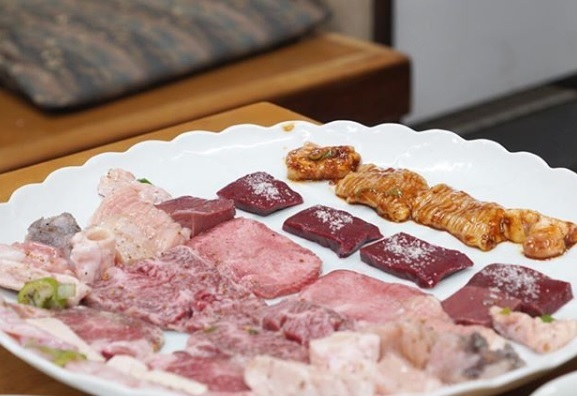
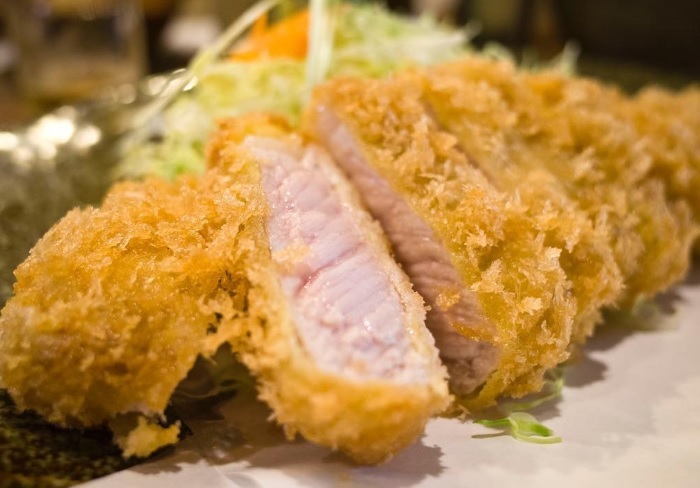
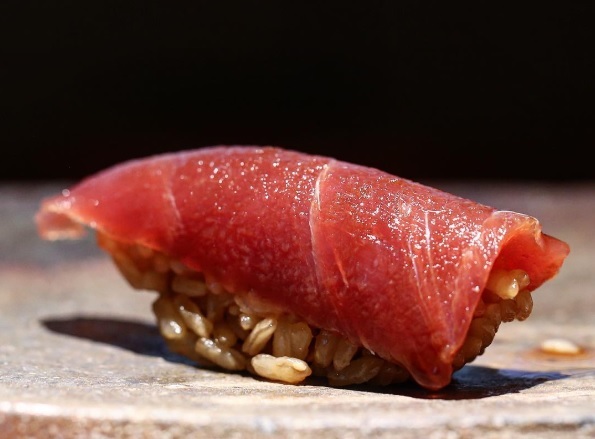
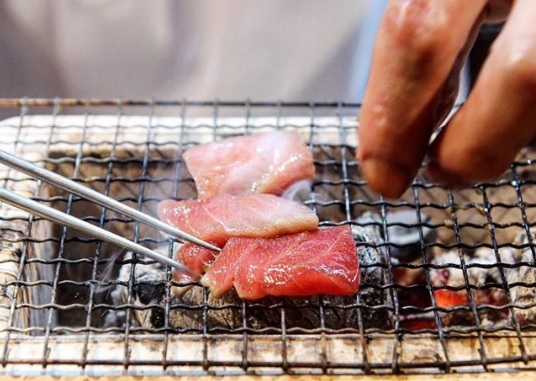





Comments 11
11
ChuToroZuke
I think with Uchida you need to go with seasoned locals. I was not aware Shinof customizations, although if you just stick with the more well known skewers you are already good with sampling. Even their shochu drinks look rather hardcore.
You can check out shinkame.co.jp and their authorized retail shop shinkame.jp (I believe outside the brewery) to see their crazy lineup. I think just start with a Shinkame Junmai and perhaps the Shinkame Hikomago Junmai and see how you like it...try both room temperature and heated to 50 C and if the shop is willing, past 50 C. Then explore the Hikomago Junmai Ginjo varietals, then the Hikomago Junmai Daiginjo
The maderia colored sake or true koshu you speak of, are aged differently under different conditions. If you go to Ginza Matsuya basement, they might have verticals of Daruma Masamune koshu spanning the last 30 years or so, and you'll see the gradation of the color shades for each vintage, as well as their higher prices. If you want to experience food pairing with koshu in a koshu specific bar/eatery, highly recommend a visit to Shu Sa Ron in Shinagawa, very close to the station. The cuisine is more western approach, although the servers will be more than glad to recommend. Koshu and braised Japanese beef cheeks with cabbage is quite fantastic with koshu. They will also give you the right glass to enjoy the various koshu with. It can get a bit overwhelming as koshu can sometimes have very high acidity.
I don't speak for OL's but my feeling is that they like to go to drinking establishments that cater more to females, and perhaps have food that is a bit lighter, less greasy, great service, yet fun but not salary man necktie around forehead boisterous. Basically ladies version of male bonding kind of joints but less subdued. But it is also a culture of going to multiple drink places. Maybe a few go in groups of both male and female...but the fun is later in the evening when you see them walking (and you can tell they are super tippsy as they can't walk in a straight line) and you'll know they are completely gone when coworkers have to help them into a taxi....
Kirakutei's owners are also good friends with the master brewer of Jikon (as well as a few of the other breweries) and they have a special relationship with the shop in Tokyo that provides it to them....the likelihood of general public going to the shop and find Jikon to purchase retail is next to zero.
ChuToroZuke
I no longer have the URLs but if you type in the Japanese name of Uchida and then the Japanese characters for strategy and then motsuyaki into google search you will find maybe a few blogs that really detail the rules. I had them bookmarked on my phone ready to check them out, but was a bit worried about falling ill with food poisoning (you never know with these things) before a trip to Hyogo prefecture.
Shinkame is probably one of the most otaku level sake out there, but if you ever get the chance try their second label Hikomago (grandchild), aged an additional year (2 for Shinkame vs 3 for Hikomago) and the resulting smoothness and complexity is ridiculously good. Some of these really dedicated traditional old school non celebrity breweries make sake that are so good that I think some of their top of the line offerings could give celebrity sake a run for their money and even pair better with food (and also at a fraction of the cost). I'm dying to try Shinkame Junmai Daiginjo and some of their crazy 10+ year aged koshu lineup, but those you will have to trek to Saitama prefecture to get it.
I think your chances of hitting a pretty decent izakaya or drinking hole in Shinbashi are far better than if you were to go to places like Ebisu Yokocho which is more for youngsters grabbing quick bites and moving on. As my friend used to say, if in Shinbashi just follow the salarymen, unless you want to scout out the OL's for eye candy haha but the venues they go to may be a bit different in vibe.
Kirakutei is excellent. Subjective but if you liked Kurosaki you will enjoy Kirakutei (the owners are very good friends with each other). It's an upscale kappo izakaya, super chill vibe. Chef's English is very limited although okami san speaks a little more (she's awesome too). Their sake is a bit lighter bodied but there are some very fun surprises, and some cult sake as well. Some don't like the place because for the same money you could eat a mid tier kaiseki restaurant, but others love this more casual relaxing format.
There are other neighborhoods much further out that are a lot of fun. Sangenjaya in Setagaya ward is completely unexplored territory for a lot of great local fun, but it's not for those who are uncomfortable wandering into a place where servers don't speak English and no English menu at all.
ChuToroZuke
@Guest/Menchikatsu
Not entirely...while there are some unicorn and harder to find sake, some of them (like Tatsuriki) are relatively easier to find. The idea is that if you come across any of the 16 at a restaurant (not Tatsuriki though), order a glass and give it a try. Especially true if it is a unicorn sake and you're willing to splurge 3000+ yen on a glass of Juyondai, and is probably a unique bottling you cannot get anywhere else.
Also no restaurant will carry all of the 16. The big problem is that there are so many sake out there and no shop tends to carry a brewery's complete portfolio (just like in the wine world). There are some breweries in the suburbs where the everyday kind of sake (honjozo, futsushu) are not sent out to Tokyo shops...in a way they are very local sake but absolutely spendid and dirt dirt cheap, like less than 1800 yen for a 720 mL bottle if a honjozo that's only available in the area where the brewery is, or a one cup sake version of it. Then some sake breweries do limited production of certain bottles because they want to play around with a different sake rice, or a different recipe altogether....then another variation, and sometimes it isn't archived and you don't see pictures of it on the internet. Think of it like table wine. Some are just absolutely splendid and pair spectacularly with local food. Hence "what grows together goes together" holds true especially in rural Japan. Although the term "terroir" is a bit debatable with wine folks in the sake world...but the concept is there.
Zaku has maybe three bottles through Mutual Trading (you mentioned New York) but they are the lower end. I have not tried them yet.
Ichita is where I tasted Denshu Junmai Daiginjo 45. Tabelog listings have beverage pictures uploaded by users, and you can always inquire about the availability of a bottle with the restaurant. Otherwise if you just ask them for sake they will pour at random. Ichita has Juyondai as well, but I find that Juyondai has a very limited and specific pairing range.... pretty much appetizer/apertif level, and if there are sweet and sour components (like a sunomono) with some texture or crunch from say, something like tobiko. Otherwise it's a waste at most sushi restaurants and quite a few izakaya. I've had the 2nd or 3rd from the top of the line (Shichitare Nijyukan) from a 1.8L bottle at Namba Hibiya, and I have to give them credit for using a Burgundy glass which allowed the sake to breathe quicker. Fantastic sipper/apertif, and perhaps it's like having a Domaine Leflaive Grand Cru with a lot of age (or Coche Dury)....but I think the money or black market pricing on Juyondai is better spent on a white Burgundy cellar selection. All Juyondai are nama or single pasteurized, but many wine collectors don't realize this and just keep it at cellar temperature. At the same time the sourcing/handling is unknown on the black market so they could be experiencing a much lower percentage of what it has been originally.
Cult sake is great, but many cult sake have limited pairings. Kind of like in the wine world to an extent. Junmai and Junmai Ginjo are fuller bodied and have a much wider pairing range than Junmai Ginjo, but if one knows what they are doing, they could pair Junmai Daiginjo with the right food, but it has to be more exacting. Or the sake has to be built in a certain way that works beyond sashimi and light clean fare.
Nothing wrong with Junmai Ginjo also, some are polished to Daiginjo levels but are still humbly called Junmai Ginjo (to keep the price down). Some JG are a bit pricier than they should be, but they're kind of like the in between....smooth enough to sip but structurally sound enough to pair with food. Think of Junmai Ginjo and Junmai Daiginjo akin to Premier Cru vs Grand Cru.
There are some Tokyo restaurants that allow corkage, most of the time not advertised, but if you politely ask they will inform you. I know L'Effervescence allows it (forgot the fee but much lower than New York) and I did it back in February (and also got an almost full sake pairing). Other restaurants won't allow corkage until you become a regular (and you also pour the master some out of courtesy). which makes sense...especially when you go the first time and you don't know what the profile of the food is like. You can also ask concierge to ask for you when you book restaurants as well. Or you bring a bottle as a gift to a friend who owns a restaurant and maybe they'll feel like drinking and sharing...but that's rare.
It is actually very sad that a lot of higher end restaurants (Japanese and non Japanese) don't take food pairing and sake into consideration. But then again traditionally, pairing with food is never thought about like wine, and some frown on that. It is the sake bars run by sake geeks that are pushing this and some of them actually do love wine as well, but they take a more specific attack and do a bang up great job with it.
Glad to have you as a reader... I was a bit worried at the lack of audience and interest in my chronicles LOL.
guest
I see, so you wrote up that vol. 3 to highlight the most well known difficult to find bottles. Excellent, right down my alley. As you might know, in the beer world, a rare and super limited bottle is called a 'white whale'. Which is exactly what gets me interested in trying. They just get snagged so quickly though.
Actually, I sought out Zaku, because it took first place at a recent sake competition, in the junmai ginjo category, ahead of two other bottles of Toyobijin. I will definitely do my rounds, and find that red bottle you mention. Do you another place I've found surprising success? The liquor section at Meidi-ya, when no other store has something, I've found stuff here, right in the front shelf.
You have a real palate for pairing sake with food, much like wine. It's really interesting to hear. Not many people understand beverage pairings. But I like where it's going. The juice pairing at Florilege really intrigued me. As far as sake goes, I usually get the chance to try new ones at sushi restaurants, picking from whatever they offer the customers throughout the course. I've also come across some interesting things that I wish I took pictures of, at restaurants like Ichita.
I took screenshots of those sakes for reference.
I too like scouring the basement floors of departments. Isetan and Ikebukuro Tobu/Seibu are some of my regular routes. But as you know, for someone not experience in sake, the selection is as daunting for a newbie as browsing wine store. Another bottle I found here, and I almost pulled the trigger on was a special release: Senkin Kamosu. Except that my luggage was way too heavy already.
On the topic of corkage, I wondered this, but didn't know how I would go about doing corkage at a Japanese restaurant. Is the corkage fee high? I would love to bring some stuff over from America, that people in Tokyo can't get.
Thank you for giving me more hope! Haha. I've been able to locate Juyondai in the past, but that was like a needle in a haystack. And as one can imagine, when you find a bottle so early in the day, it's not easy to haul it around as you walk from place to place. I am definitely on the hunt for a nice bottle of Denshu on my next visit.
Sounds like Nabeshima is a bit more rare eh? I thought it'd be the opposite way around. But I get them mixed up sometimes. Hibiya Midtown is the place to be now it seems... in terms of upping your business prices. Ryugin, Sushi Namba... even a branch of Buvette. Which by the way, is amazing, if you ever visit New York City.
I would love to bring back many bottles! But the sheer weight is a lot to carry, haha. You are absolutely right. I've gone under the impression, and people tell me, that junmais have more taste, because not as much of the rice if polished off, and you lose it. I feel that these days, too much glory is placed on the idea of junmai ginjo, that uneducated new sake drinkers get the wrong idea. And they think, "so... only drink junmai daignjo, it's the best, why drink anything else?" So they fall for it, when a company like Dassai mass produces, rushes, and makes sloppy milled batches of rice, but meet the criteria to name it a junmai daiginjo, when smaller craft sake makers are doing better junmai. Not knowing that they're missing out on so much from other types of sake. I compare this to the idea of Starbucks Reserve beans, which can't compare to superior (cheaper) small batch roasters. I especially find savory and aged sakes exciting.
And thank you for the tip on the nama sake. I usually just have the hotel hold any bottle I get, and hope for the best during the commute. I once grabbed an unpasteurized bottle from Nara. Seemed ok when I tried it. I didn't get sick :D
Please do another article sometime. I am about to read your one on the proper way of ordering. I also wish the site would have more articles on other topics too, like a full magazine.
Menchikatsu
Just a brief follow up, on something we talked about before. Tonight, I brought a bottle of Shinkame Hikomago junmai to an upscale izakaya, and had it corkaged. The boss brought up, that he used to have a kandouko sake warmer 燗銅壺, but not anymore, so they heated it up in a hot water pot for me. It drops in temperature very quickly using this method! The bottle recommends it at 55-60 degrees celsius, which I liked it most at... though I burnt my tongue. 45 degrees it's still good, but the taste is definitely different. I brought my own thermometer, which got a laugh out of the staff. Drank it with a variety of shellfish (local abalone, oysters), sashimi (tako, fatty fish), and various types of snacks. People seated next to me were from Kyushu, and are regulars at wagyu restaurants in Tokyo, like Yoroniku and Jambo Hanare. I shared some sake with them. They were drinking satsuma shochu. They tell me, apparently Fukuoka is more shochu territory.
Read more